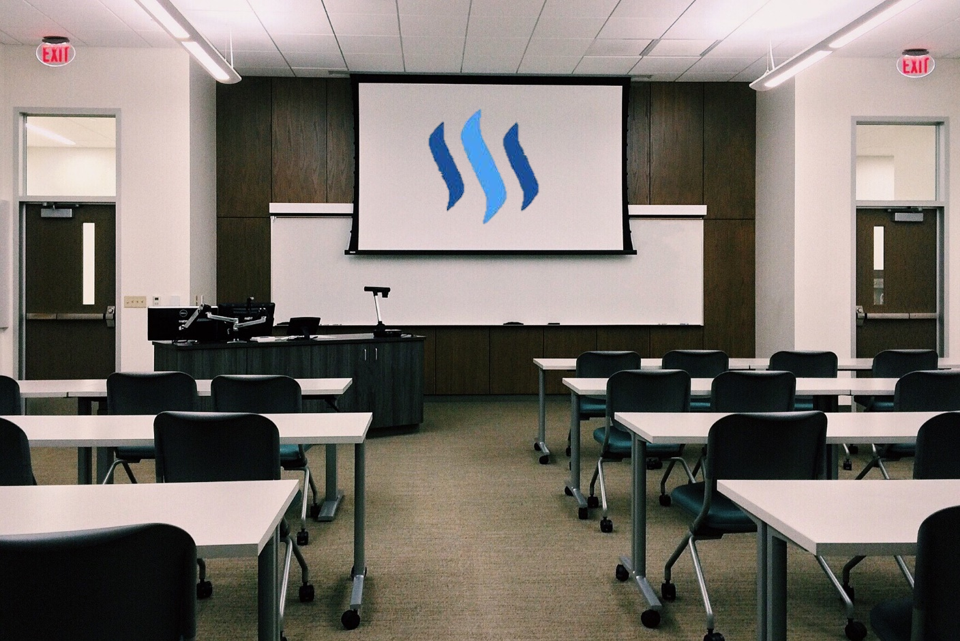The STEEM Classroom PlayTest

This exercise was prepared for the MIT Teaching Systems Labs PlayTest on November 8, 2017.
For this PlayTest, we will all be experimenting with the Steem blockchain, learning about how to set up an account, transfer tokens, and use the Steem blockchain to conduct an open discussion and earn rewards for thoughtful contribution.
Part 1: Blockchain
What is a Blockchain?
A blockchain is a continuously growing list of records. This list of records is decentralized, meaning that rather than being stored on one server, every node in the network gets a full copy of the database. When a new transaction is made, it is added to the existing list (aka a block) of records, chained back to previous blocks of records (thus a "block"-"chain"), and broadcast to everyone else's copy of the database. The computers that upkeep the blockchain are called "miners", and anyone can set one up.
To transact on a blockchain, you need to generate a public key and a private key. The public key is your "address" that transactions are sent to and from. Your private key is the password you use to sign off on transactions.
Bitcoin uses a blockchain to store transactions and rewards miners with newly minted Bitcoin.
What is Steem?
For this exercise, we will be looking at the Steem blockchain. Steem is a blockchain that stores social media. People can write posts and comment on, upvote, and resteem each other's posts. All these transactions are recorded on a blockchain.
On Steem, mining rewards are pooled together and distributed out weekly to all of the users proportional to the upvotes they get on their posts and comments that week. This means that not only are you rewarded for the posts you write, but the more upvotes you get on your posts, the higher the payout is.
When you do something on Steem, your transaction is stored on the Steem blockchain. There is no central server for the Steem blockchain. This means that as long as one computers in the world is running the Steem blockchain, Steem is live.
1. Create an account through Steemit
On Steem, public addresses look like usernames. You can create a Steemit account through Steemit.com with your email address and phone number. These are for recovery reasons. Keep your password safe at all times, as it could be hard to recover.
With your profile, you can post, comment, upvote, and resteem others' posts.
2. Your Wallet. Sending an Receiving Transactions.
Your Steem account is a wallet that contain funds which you can transfer to other people. Check out your wallet in your Profile page. Try sending 0.01 STEEM to someone else.
The amount in your wallet can be cashed out onto an exchange and sold for Bitcoin, which is convertible to fiat.
3. Discussion and Upvoting
You can upvote this post, which would increase the potential "payout" of the post. Both the author and the upvoter get rewards from the post.
If you write a comment on this post and someone upvotes it, you also earn rewards from that too.
Try writing one now and commenting with a hello. It instantly shows up not only on steemit.com but on any other website that pulls its data from the Steem blockchain. Upvote the comment of one your peers and watch their potential payout increase. If more people upvote your response, the amount you earn goes up even more.
4. One blockchain, multiple websites
Steemit.com is a website build on top of the Steem blockchain. If Steemit.com were to go down, Steem will still be up and running. For example, busy.org is another website that interacts with the Steem blockchain. Check out this post on busy.org: https://busy.org/beginners/@aprendor/the-steem-classroom-playtest .
For another example, check out this post on steemd.com: https://steemd.com/beginners/@aprendor/the-steem-classroom-playtest. Steemd.com is a "blockchain" explorer, that shows you a lot of additional details about each transaction on the Steem blockchain.
One last example. Steepshot.io is an Instagram like service built on the Steem blockchain. It's focus is on pictures, and the website filters out Steem posts, looking for the ones that have the steepshot tag.
5. The Steem Classroom
Now that you've gotten a sense about how Steem works, let's talk about Steem for education. How could this help teachers? If a teacher holds posts an assignment on a Steemit post, students can have an open discussion in the comments, and are rewarded for thoughtful contribution. The above was an example of how this would work.
Open Discussion What have you found interesting about the STEEM blockchain. What do you think of the prospect of rewarding students with money? Will it enable students to earn money while learning, or will it hinder intrinsic motivation for learning?
Thoughts?
I wonder if used in the classroom, how to encourage students to only upvote content they think is beneficial. Would they only comment and upvote to help certain people earn tokens vs what learning material they actually find useful?
Can you send steem tokens for "real life" interactions?
this is an interesting idea
I am wondering this might work better in higher education to encourage students to facilitate crowd sourcing in education
this might be more applicable in higher education.
How does regulation work here, if at all? You know for things like graphic content or hate speech. I understand the desire for no central control, but given everything that companies like Facebook are facing right now around fake news, I don't know how you deal with that. This is not really related to the educational application...
The educational application here is interesting. This could solve the lack of genuine digital community behavior in LMS discussions.